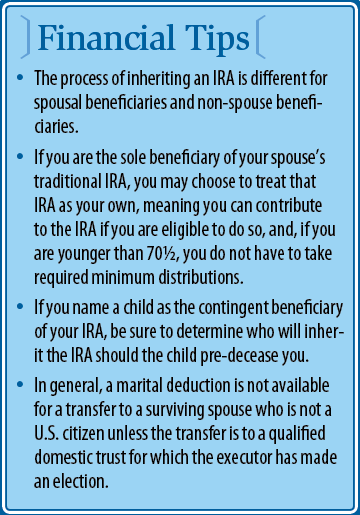Article
IRA beneficiaries: Know who receives what
Understanding the impact that the beneficiary designation has on the payout of an individual retirement account after the IRA owner dies is a critical element of the planning process.
How does the beneficiary designation of an IRA impact future distributions?
Individual retirement accounts (IRAs) generally represent most physicians’ largest financial asset. With this in mind, it only makes sense to ensure that retirement account beneficiary decisions are carefully made. While many institutions provide custody services for traditional IRA assets, the onus is on the IRA owner to make the ultimate beneficiary decision.
Related: IRA rollovers can be beneficial, but be careful

Unfortunately, many physicians don’t take the time to understand and personally individualize the beneficiary language within the agreement to meet their specific objectives. Understanding the impact that the beneficiary designation has on the payout of the account after the IRA owner dies is a critical element of the planning process.
From the standpoint of those who inherit a traditional IRA (as opposed to a Roth IRA), it's important to have an understanding of the unique rules associated with the process, which is different for spousal beneficiaries and non-spouse beneficiaries.
If you are the sole beneficiary of your spouse’s traditional IRA, you may choose to treat that IRA as your own. This means you can contribute to the IRA if you are eligible to do so, and, if you are younger than 70½, you do not have to take required minimum distributions (RMDs). RMDs are generally required after reaching age 70½. As an alternative, you may leave the IRA in your spouse’s name with you as the beneficiary. If your deceased spouse died after age 70½, you generally must base subsequent RMDs on the longer of your single life expectancy or the deceased’s life expectancy. Otherwise, distributions may be based on your single life expectancy or the account must be totally liquidated in 5 years. Another possible option is to roll over the inherited IRA assets into your own IRA. The rollover is exempt from current tax liability if completed within 60 days.
NEXT: You inherit an IRA from someone other than your spouse
If, on the other hand, you inherit an IRA from someone other than your spouse, you cannot treat the IRA as your own. Thus, you are not allowed to make subsequent contributions to the inherited IRA, nor can you can roll over the funds to your own IRA. You must begin taking RMDs subject to the rules for IRA beneficiaries. Distributions from an inherited IRA are taxed at ordinary income tax rates. If you fail to take an RMD, you must pay a penalty tax equal to 50% of the required amount of the distribution.

Typically, married IRA owners will name their spouse as beneficiary, due to the many advantages of doing so, while either not naming or giving very little consideration to whom the contingent beneficiary should be. Those who do name a contingent beneficiary often name their children. Caution does need to be exercised in the event that one of the named children dies prior to the IRA owner. Typically, the deceased child’s portion of the inheritance would go to the other living children, as opposed to the deceased child’s family. This may indeed be your objective.
However, if your intention is to have your child’s portion pass through to their heirs, be sure to add the line: “to my descendants per stirpes.” The Latin term “per stirpes” means “by right of the deceased.” This specific legal terminology will ensure that if the beneficiary child dies, his/her descendants get the full share.
Read: ‘Step up’ to estate tax savings under this rule
There are many IRA intricacies and nuances that should be addressed proactively to ensure you are maximizing both income tax and estate tax planning opportunities. Be sure to consult with your tax or financial adviser to ensure your IRA is structured properly now in order to avoid surprises or problems in the future.
NEXT: How do I leave assets to my spouse, who isn't a U.S citizen?
How do I leave assets to my spouse, who is not a U.S. citizen, and still minimize estate taxation?
In general, a marital deduction is not available for a transfer to a surviving spouse who is not a U.S. citizen unless the transfer is to a qualified domestic trust (QDOT) for which the executor has made an election. A QDOT must qualify for the marital deduction as well as meet the following requirements:
- At least one trustee of the QDOT must be a U.S. citizen or a domestic corporation.
- No distribution (other than a distribution of income) may be made from the trust unless that trustee has the right to withhold any additional gift or estate tax imposed on the trust.
Additional estate tax is due on any property remaining in the QDOT upon death of the surviving spouse (or at the time the trust ceases to qualify as a QDOT, if earlier).
More Money Matters
‘Step up’ to estate tax savings under this rule
Calculate risk/return with this time-tested strategy
Life insurance: Selecting the owner of your policy
Subscribe to Urology Times to get monthly news from the leading news source for urologists.

















